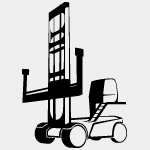 Container stackers are specially designed for the handling of containers on trains, ships or trucks. The biggest challenge for a container stacker is the handling of heavy loads while keeping its counterweight mechanism balanced. The difference between a container stacker and a reach Stacker is that the container stacker can only reach and stack up to the first row while a reach stacker stacks up to the third row. Therefore the weight of a container truck is about 70 tons much lower than a reach stacker. The capacity of an empty container stacker is around the 10 tons mark whilst a full container trucks usually can lift around the 40 tons mark. Some models of the empty container handlers have a double lift frame enabling it to raise two empty containers at once. They usually run on diesel but there are also electric engine versions.
Container stackers are specially designed for the handling of containers on trains, ships or trucks. The biggest challenge for a container stacker is the handling of heavy loads while keeping its counterweight mechanism balanced. The difference between a container stacker and a reach Stacker is that the container stacker can only reach and stack up to the first row while a reach stacker stacks up to the third row. Therefore the weight of a container truck is about 70 tons much lower than a reach stacker. The capacity of an empty container stacker is around the 10 tons mark whilst a full container trucks usually can lift around the 40 tons mark. Some models of the empty container handlers have a double lift frame enabling it to raise two empty containers at once. They usually run on diesel but there are also electric engine versions.
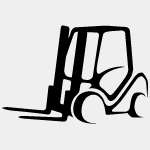 Counterbalance forklifts, also known as a forkift trucks, fork trucks or forklifts, are the most common type of material handling equipment and are characterised by a lifting unit, which consists of a mast and, typically, a forklift fork with 1.2 metres distance between the forks. This forklift enables the lifting, transportation and stacking of goods. Counterbalance forklifts can be used for all possible applications and in many different ways. For example, low noise and zero emission electric trucks are used mainly indoors and warehouses. On the other hand, internal combustion trucks, petrol or diesel engine forklifts, are more frequently used for outdoors. The front driver’s seat is behind the mast. The maximum height should not exceed 2 metres therefore the driver’s seat is normally an open seat or a cabin with a steel frame. For use outdoors large forklifts often have a closed cabin to operate regardless of weather conditions. The engines are located towards the front of truck under the driver’s seat to ensure low centre of gravity and provide more stability to the truck while driving and stacking. Rear-wheel steering is easy to handle and manoeuvre while front loaders are ideal for working in narrow aisles and warehouses. A distinction is made between the 3 wheel and the 4 wheel electric truck types, which have both an electric engine and tend to be one metre wide. A 4 wheel fork truck can take a higher load capacity and offer offer more stability, while a 3 wheel forklift truck can work better in tighter spaces and has an extremely high level of maneuverability. Forklifts have a lifting bearing load from 1 ton to 8 tons. In general the capacity of internal combustion forklifts is higher than that of electric forklifts. The height of the truck is determined by the nature of their mast. The mast can be constructed as a duplex (two stages) or triplex (three stages). This design allows the masts to extend hydraulically to two or three times its length allowing for loading levels to between four and seven metres. A wide range of attachments turns any forklift into a versatile all-rounder material handling equipment. More information about forklift attachments can be found in Forklift.
Counterbalance forklifts, also known as a forkift trucks, fork trucks or forklifts, are the most common type of material handling equipment and are characterised by a lifting unit, which consists of a mast and, typically, a forklift fork with 1.2 metres distance between the forks. This forklift enables the lifting, transportation and stacking of goods. Counterbalance forklifts can be used for all possible applications and in many different ways. For example, low noise and zero emission electric trucks are used mainly indoors and warehouses. On the other hand, internal combustion trucks, petrol or diesel engine forklifts, are more frequently used for outdoors. The front driver’s seat is behind the mast. The maximum height should not exceed 2 metres therefore the driver’s seat is normally an open seat or a cabin with a steel frame. For use outdoors large forklifts often have a closed cabin to operate regardless of weather conditions. The engines are located towards the front of truck under the driver’s seat to ensure low centre of gravity and provide more stability to the truck while driving and stacking. Rear-wheel steering is easy to handle and manoeuvre while front loaders are ideal for working in narrow aisles and warehouses. A distinction is made between the 3 wheel and the 4 wheel electric truck types, which have both an electric engine and tend to be one metre wide. A 4 wheel fork truck can take a higher load capacity and offer offer more stability, while a 3 wheel forklift truck can work better in tighter spaces and has an extremely high level of maneuverability. Forklifts have a lifting bearing load from 1 ton to 8 tons. In general the capacity of internal combustion forklifts is higher than that of electric forklifts. The height of the truck is determined by the nature of their mast. The mast can be constructed as a duplex (two stages) or triplex (three stages). This design allows the masts to extend hydraulically to two or three times its length allowing for loading levels to between four and seven metres. A wide range of attachments turns any forklift into a versatile all-rounder material handling equipment. More information about forklift attachments can be found in Forklift.
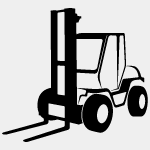 The rough terrain forklift is a 4×4 all-wheel drive counterbalanced truck built and designed to work outdoors and in difficult rough terrain. Depending on the working conditions there are different options and models of rough terrain forklift trucks. The large truck tyres are recommended for potholes and uneven surfaces. Their distinct advantage is an optimal off-road capability and a high ground clearance. For industrial premises there are trucks with industrial tyres, which allow for a smooth running and good handling features on asphalted terrain or concrete surface. In the case of a muddy and rather hilly dirt work surfaces the most ideal option is to use an off-road truck with four-wheel drive. The rule of thumb is to use a terrain forklift always according to the handling conditions and to ensure an efficient and productive organisation of the work load and a maximum safety for the driver. Most of the rough terrain forklifts are diesel engine, but there are also LPG or petrol engine versions. In addition, these lift trucks are available in four-or six-speed pneumatic tyres. Hydrostatic transmissions are common in these trucks but are also available with mechanical or hydrodynamic gear transmissions. There are also terrain forklift trucks with articulated joints for a high degree of mobility, and with differential locking system with two-and four-wheel drive steering. An all-terrain forklift must have a high stability and resistance stance and must be built with a robust mast and a monobloc chassis. Rough terrain forklifts can have a vertical tower, which lifts loads straight up, or a telescoping boom, which lifts loads up and out from the base of the machine.The most common applications for off-road trucks are the forestry, wood, mining, recycling, construction, concrete, brick works and heavy industry. Therefore rough terrain forklifts are not only used very efficiently in difficult terrain but also in other areas. For example, it is of great benefit to businesses with outside storage areas, event industry and military installations. Today, rough terrain forklifts are a common sight on construction projects. They handle everything from pallets of concrete block to stacks of plywood to roof beams. The larger models use a telescopic boom with lifting capacities of up to 4,540 kg, vertical reaches of up to 12 metres and forward reach of 7 metres or more
The rough terrain forklift is a 4×4 all-wheel drive counterbalanced truck built and designed to work outdoors and in difficult rough terrain. Depending on the working conditions there are different options and models of rough terrain forklift trucks. The large truck tyres are recommended for potholes and uneven surfaces. Their distinct advantage is an optimal off-road capability and a high ground clearance. For industrial premises there are trucks with industrial tyres, which allow for a smooth running and good handling features on asphalted terrain or concrete surface. In the case of a muddy and rather hilly dirt work surfaces the most ideal option is to use an off-road truck with four-wheel drive. The rule of thumb is to use a terrain forklift always according to the handling conditions and to ensure an efficient and productive organisation of the work load and a maximum safety for the driver. Most of the rough terrain forklifts are diesel engine, but there are also LPG or petrol engine versions. In addition, these lift trucks are available in four-or six-speed pneumatic tyres. Hydrostatic transmissions are common in these trucks but are also available with mechanical or hydrodynamic gear transmissions. There are also terrain forklift trucks with articulated joints for a high degree of mobility, and with differential locking system with two-and four-wheel drive steering. An all-terrain forklift must have a high stability and resistance stance and must be built with a robust mast and a monobloc chassis. Rough terrain forklifts can have a vertical tower, which lifts loads straight up, or a telescoping boom, which lifts loads up and out from the base of the machine.The most common applications for off-road trucks are the forestry, wood, mining, recycling, construction, concrete, brick works and heavy industry. Therefore rough terrain forklifts are not only used very efficiently in difficult terrain but also in other areas. For example, it is of great benefit to businesses with outside storage areas, event industry and military installations. Today, rough terrain forklifts are a common sight on construction projects. They handle everything from pallets of concrete block to stacks of plywood to roof beams. The larger models use a telescopic boom with lifting capacities of up to 4,540 kg, vertical reaches of up to 12 metres and forward reach of 7 metres or more
These trucks are very helpful in every day’s work for employees – whether in a large manufacturing or production plant, a warehouse of a local supermarket or just on the back of a lorry. Pallet trucks are easy to use, small and flexible and allow easy transport of pallets and other goods without the tedious manual work. There are different versions of the popular pallet trucks for ground level transportation and loading and unloading of goods:
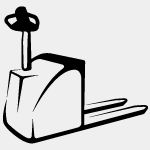 These are usually operated on foot, but there are also lifting trucks with platform or so-called sit-on or stand- on reach truck. The pallet consists of two forks, rear double wheels, load wheels in front and a rigid handle operated by hydraulic lift through which the goods can be lifted from the ground so that they can be transported. The average height of low-lift trucks are between 80 mm and 250 mm and have a load capacity of up to 2 tons.
These are usually operated on foot, but there are also lifting trucks with platform or so-called sit-on or stand- on reach truck. The pallet consists of two forks, rear double wheels, load wheels in front and a rigid handle operated by hydraulic lift through which the goods can be lifted from the ground so that they can be transported. The average height of low-lift trucks are between 80 mm and 250 mm and have a load capacity of up to 2 tons.
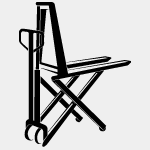 The High Lifter / Scissors Lifts can be like any ordinary hand pallet truck. The main difference between the two devices is the height. With the help of a hydraulic pump goods weighing up to 1000 kgs can be lifted up to 800 mm. There are also electric models which are operated by a battery. High Lifters are a great aid to many employees in logistics centers because the loads do not have to be handled or lifted by hand.
The High Lifter / Scissors Lifts can be like any ordinary hand pallet truck. The main difference between the two devices is the height. With the help of a hydraulic pump goods weighing up to 1000 kgs can be lifted up to 800 mm. There are also electric models which are operated by a battery. High Lifters are a great aid to many employees in logistics centers because the loads do not have to be handled or lifted by hand.
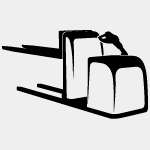 Pickers or order pickers are used for order preparation operations in which the driver’s seat in a driving position – in contrast to the conventional lift trucks or forklifts – can be raised to working height. Order pickers differ mainly by the different heights. So there are low level, intermediate level and high level order pickers.
Pickers or order pickers are used for order preparation operations in which the driver’s seat in a driving position – in contrast to the conventional lift trucks or forklifts – can be raised to working height. Order pickers differ mainly by the different heights. So there are low level, intermediate level and high level order pickers.
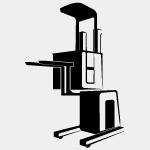 The high level order picker have a lifting height of up to 14500 mm and a capacity of up to 2000 kgs. Many models allow for the cab or driver’s seat to be raised together with the goods. The storage of goods can be done in two different ways: manually with the storage and retrieval of the load with rigid forks and a platform or mechanical with forks moving through the driver’s seat. Like the low level order picker the high level order picker can also be operated automatically.
The high level order picker have a lifting height of up to 14500 mm and a capacity of up to 2000 kgs. Many models allow for the cab or driver’s seat to be raised together with the goods. The storage of goods can be done in two different ways: manually with the storage and retrieval of the load with rigid forks and a platform or mechanical with forks moving through the driver’s seat. Like the low level order picker the high level order picker can also be operated automatically.
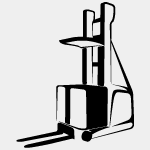 Medium level order pickers are used primarily for transportation of loads up to 6000 mm with a capacity of up to 2500 kgs. They usually have an operator platform or a seat but can also be used without a driver.
Medium level order pickers are used primarily for transportation of loads up to 6000 mm with a capacity of up to 2500 kgs. They usually have an operator platform or a seat but can also be used without a driver.
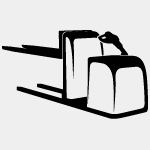 Low level order picker are used mainly for storage and transportation of loads up to 2000 mm with a capacity of up to 2500 kgs.
Low level order picker are used mainly for storage and transportation of loads up to 2000 mm with a capacity of up to 2500 kgs.
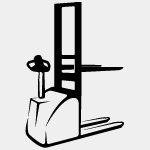 Stackers are available with a manual or a mechanical lift. Manual lift is aided by a hydraulic valve which is operated by hand or foot. To allow for the smooth lowering of the load the valve is opened slowly. The hand-operated stackers have a load capacity up to 1,200 kg and a maximum lift height of up to 2,000 mm. The most common stackers are the electric type with a lifting capacity of up to 2,500 kg and reaching heights of up to 5,500 mm. The operator walks with the stacker or can seat in the driver’s cab. Reach stackers are preferred for their excellent maneuverability and ease of operation in the entire logistics industry.
Stackers are available with a manual or a mechanical lift. Manual lift is aided by a hydraulic valve which is operated by hand or foot. To allow for the smooth lowering of the load the valve is opened slowly. The hand-operated stackers have a load capacity up to 1,200 kg and a maximum lift height of up to 2,000 mm. The most common stackers are the electric type with a lifting capacity of up to 2,500 kg and reaching heights of up to 5,500 mm. The operator walks with the stacker or can seat in the driver’s cab. Reach stackers are preferred for their excellent maneuverability and ease of operation in the entire logistics industry.
 Stackers differ substantially from conventional forklifts by the lack of a driver’s seat. The stacker is designed as a pedestrian device, while some models have a fold-out driving position. Due to the lack of driver’s seat these machines are much more compact and therefor more agile than conventional stacker forklifts and are preferred, especially in small and cramped spaces.
Stackers differ substantially from conventional forklifts by the lack of a driver’s seat. The stacker is designed as a pedestrian device, while some models have a fold-out driving position. Due to the lack of driver’s seat these machines are much more compact and therefor more agile than conventional stacker forklifts and are preferred, especially in small and cramped spaces.
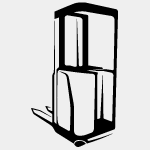 They belong to rider stackers range. The advantages of the stacker stand on – compared to a conventional reach truck – is that they are very compact and can work in very small spaces and aisles with increased safety and comfort for the operator. With extremely small turning circle the operator enjoys on-off access, a comfortable standing position, good visibility and highly efficient fly-by-wire steering.
They belong to rider stackers range. The advantages of the stacker stand on – compared to a conventional reach truck – is that they are very compact and can work in very small spaces and aisles with increased safety and comfort for the operator. With extremely small turning circle the operator enjoys on-off access, a comfortable standing position, good visibility and highly efficient fly-by-wire steering.
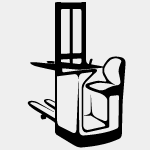 They are part of the rider stackers range. Sit-on stacker specifically designed for transport distances of about 100 metres and 5 hours per day. A reach truck is more suitable for longer transport routes and operating times and tends to be between 25 and 50 percent more expensive and often yields a better result. The tight turning circle radius makes it a popular device in narrow halls and areas.
They are part of the rider stackers range. Sit-on stacker specifically designed for transport distances of about 100 metres and 5 hours per day. A reach truck is more suitable for longer transport routes and operating times and tends to be between 25 and 50 percent more expensive and often yields a better result. The tight turning circle radius makes it a popular device in narrow halls and areas.
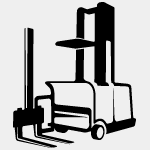 Narrow aisle trucks (or VNAs – Very Narrow Aisle trucks) are the perfect solution for optimal space utilisation. These trucks are also used in corridors which are slightly wider than the truck itself. They provide 100 percent maneuverability and take less place to operate providing for more storage space. Narrow aisle trucks usually have a capacity between 800 kgs and 2000 kgs and a height of between 3 to over 13 metres.
Narrow aisle trucks (or VNAs – Very Narrow Aisle trucks) are the perfect solution for optimal space utilisation. These trucks are also used in corridors which are slightly wider than the truck itself. They provide 100 percent maneuverability and take less place to operate providing for more storage space. Narrow aisle trucks usually have a capacity between 800 kgs and 2000 kgs and a height of between 3 to over 13 metres.
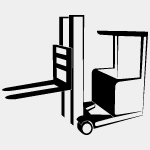 Reach trucks are designed primarily for the transport of long and bulky goods. Most models are powered by diesel or electric engines. The driver sits on the side of the unit and operates the mast from this point, which is pushed forward and where it can be lowered to the ground. The boom is retracted and the load sits inside the supporting arms. Therefore heavy loads can be transported safely and without the need of the counterweight found in a typical forklift. Among the current models there are also versions with a side mast. Side-loading trucks normally operate to one side of the aisle and place the load laterally.
Reach trucks are designed primarily for the transport of long and bulky goods. Most models are powered by diesel or electric engines. The driver sits on the side of the unit and operates the mast from this point, which is pushed forward and where it can be lowered to the ground. The boom is retracted and the load sits inside the supporting arms. Therefore heavy loads can be transported safely and without the need of the counterweight found in a typical forklift. Among the current models there are also versions with a side mast. Side-loading trucks normally operate to one side of the aisle and place the load laterally.
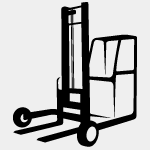 As their name implies, this forklift is designed in such a way that it can be transported at the rear of the lorry or truck. Upon the arrival to the premises the truck can be set up in a very short period of time allowing for a fast and saving time in the loading and unloading of the goods. Compared to conventional forklift, the truck mounted forklifts has much lower weight and are very easy to manouvre and take lighter load. The bigger advantages are: Being able to mechanically self unload offers advantages as an inevitable part of any transport operation is that the goods are loaded at one end of the journey and unloaded at the other. Simply a truck mounted forklift easily attached or detached from the carrying vehicle. So it offers not only the flexibility but also can reduce a lot of time and therefore in many cases is far more cost effective.
As their name implies, this forklift is designed in such a way that it can be transported at the rear of the lorry or truck. Upon the arrival to the premises the truck can be set up in a very short period of time allowing for a fast and saving time in the loading and unloading of the goods. Compared to conventional forklift, the truck mounted forklifts has much lower weight and are very easy to manouvre and take lighter load. The bigger advantages are: Being able to mechanically self unload offers advantages as an inevitable part of any transport operation is that the goods are loaded at one end of the journey and unloaded at the other. Simply a truck mounted forklift easily attached or detached from the carrying vehicle. So it offers not only the flexibility but also can reduce a lot of time and therefore in many cases is far more cost effective.
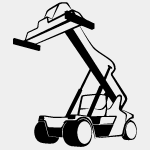 Just like a container stacker, reach stackers fall under the category of the large counterbalance forklifts. While a container stacker can only reach up to the first row, a reach Stacker can carry around 50 tons through the telescopic arm up to the third row and a maximum 6-fold stacked one above the other. A fully equipped reach stacker can carry up to 100 tons. A reach stacker is protected by various extensions and is used by many companies instead of expensive container cranes.
Just like a container stacker, reach stackers fall under the category of the large counterbalance forklifts. While a container stacker can only reach up to the first row, a reach Stacker can carry around 50 tons through the telescopic arm up to the third row and a maximum 6-fold stacked one above the other. A fully equipped reach stacker can carry up to 100 tons. A reach stacker is protected by various extensions and is used by many companies instead of expensive container cranes.
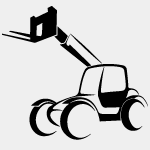 Telehandlers also known as telescopic forklifts are especially used in construction, agriculture and industrial sites. This type of forklifts can achieve lifting height of up to 30 metres. Telehandlers are rigid frames machines or semi rigid frame machines. Telehandlers can come with a fully swiveling truck superstructure called rotor which are referred to rotor or rotating telehandlers. The maximum load in the current models can be up to 21 tonnes. Telehandlers usually have a four-wheel-drive diesel engine and an oscillating rear axle to achieve optimal off-road capability. The operator can select the telescopic lift truck operating modes for a more flexible and efficient. Telehandlers are very versatile machines due to the free attachment section at the head of the telescopic arm which allows for multiple attachments to be installed.
Telehandlers also known as telescopic forklifts are especially used in construction, agriculture and industrial sites. This type of forklifts can achieve lifting height of up to 30 metres. Telehandlers are rigid frames machines or semi rigid frame machines. Telehandlers can come with a fully swiveling truck superstructure called rotor which are referred to rotor or rotating telehandlers. The maximum load in the current models can be up to 21 tonnes. Telehandlers usually have a four-wheel-drive diesel engine and an oscillating rear axle to achieve optimal off-road capability. The operator can select the telescopic lift truck operating modes for a more flexible and efficient. Telehandlers are very versatile machines due to the free attachment section at the head of the telescopic arm which allows for multiple attachments to be installed.
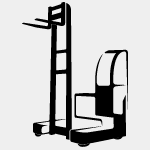 Four-way side loaders usually come as electric internal combustion engines and are designed to transport and stack long, bulky goods in confined spaces. The most common work areas for 4-way side loaders are the timber industry and wood processing or where long steel or plastic pipes are moved. The four-way side loader lifts the goods with lateral forks and places it on a frame – a platform on one side of the truck. All 4-way forklifts have a multi directional steering which means they can rotate their 4 wheels by 90 degrees; this allows the side loader to have an extremely small turning circle angle and therefore can be used instead of a common side loader where the area is far too small.
Four-way side loaders usually come as electric internal combustion engines and are designed to transport and stack long, bulky goods in confined spaces. The most common work areas for 4-way side loaders are the timber industry and wood processing or where long steel or plastic pipes are moved. The four-way side loader lifts the goods with lateral forks and places it on a frame – a platform on one side of the truck. All 4-way forklifts have a multi directional steering which means they can rotate their 4 wheels by 90 degrees; this allows the side loader to have an extremely small turning circle angle and therefore can be used instead of a common side loader where the area is far too small.
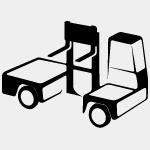 Side loaders usually have an electric, diesel or gas-powered and are designed to transport and stack long, bulky goods in confined spaces. The most common areas of work for side loader are the timber industry and wood processing or where long steel or plastic pipes need to be transported. The truck lifts the load with the lateral fork and places it on the platform – a shelf on one side of the truck. The commercial side loader has a lifting capacity 1000-6000 kgs with a lifting height of between 3000 to 8000 mm.
Side loaders usually have an electric, diesel or gas-powered and are designed to transport and stack long, bulky goods in confined spaces. The most common areas of work for side loader are the timber industry and wood processing or where long steel or plastic pipes need to be transported. The truck lifts the load with the lateral fork and places it on the platform – a shelf on one side of the truck. The commercial side loader has a lifting capacity 1000-6000 kgs with a lifting height of between 3000 to 8000 mm.
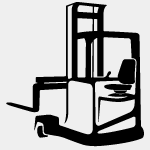 Especially for long loads, these devices can work sideways but can also have frontal access and can alter their direction of travel as needed. Capacity from 2 to 2.5 tonnes and a lift height of up to 8000 mm.
Especially for long loads, these devices can work sideways but can also have frontal access and can alter their direction of travel as needed. Capacity from 2 to 2.5 tonnes and a lift height of up to 8000 mm.

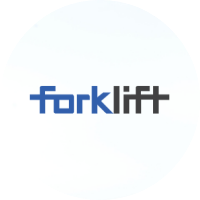
Country Manager Spain
+49 941-942794-24